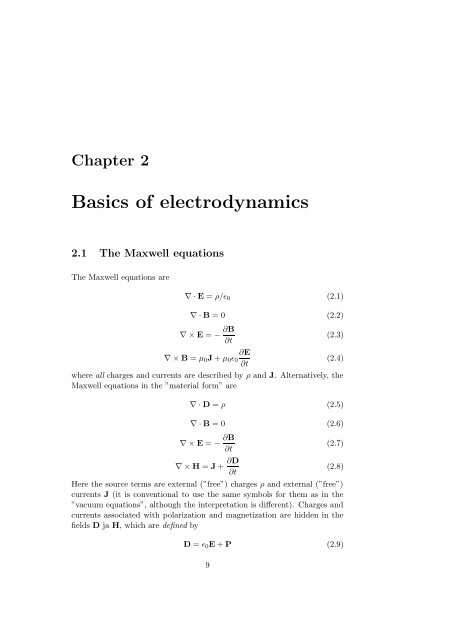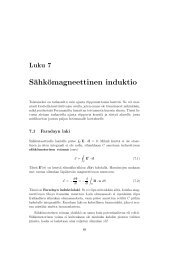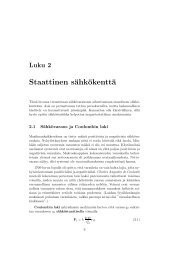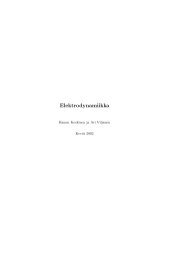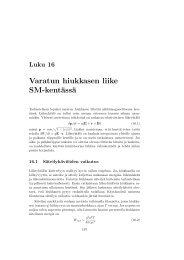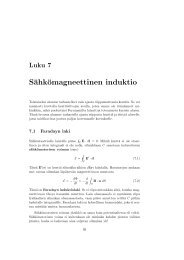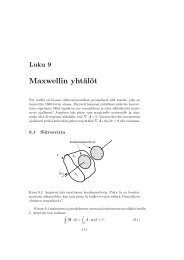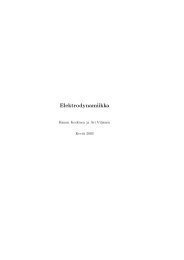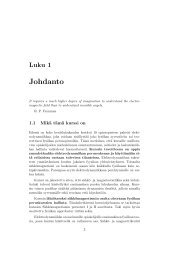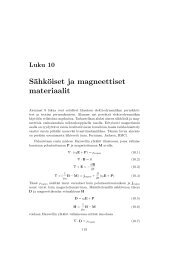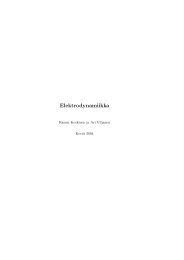Basics of electrodynamics - FMI
Basics of electrodynamics - FMI
Basics of electrodynamics - FMI
You also want an ePaper? Increase the reach of your titles
YUMPU automatically turns print PDFs into web optimized ePapers that Google loves.
Chapter 2<strong>Basics</strong> <strong>of</strong> <strong>electrodynamics</strong>2.1 The Maxwell equationsThe Maxwell equations are∇ · E = ρ/ɛ 0 (2.1)∇ · B = 0 (2.2)∇ × E = − ∂B∂t(2.3)∂E∇ × B = µ 0 J + µ 0 ɛ 0 (2.4)∂twhere all charges and currents are described by ρ and J. Alternatively, theMaxwell equations in the ”material form” are∇ · D = ρ (2.5)∇ · B = 0 (2.6)∇ × E = − ∂B∂t∇ × H = J + ∂D∂t(2.7)(2.8)Here the source terms are external (”free”) charges ρ and external (”free”)currents J (it is conventional to use the same symbols for them as in the”vacuum equations”, although the interpretation is different). Charges andcurrents associated with polarization and magnetization are hidden in thefields D ja H, which are defined byD = ɛ 0 E + P (2.9)9
10 CHAPTER 2. BASICS OF ELECTRODYNAMICSH = B µ 0− M (2.10)Here P is the polarization (density <strong>of</strong> electric dipole moment vectors) andM is the magnetization (density <strong>of</strong> magnetic dipole moment vectors).We need to know the constitutive relations D = D(E, B) and H =H(E, B), because the fields B and E are the ones which we finally want todetermine. We will mostly deal with simple materials for which the followingrelations hold:D = ɛE (2.11)H = B µ(2.12)We also assume that Ohm’s law is valid in its simple formJ = σE (2.13)Here permittivity, permeability and conductivity are scalars. We allow aspatial dependence with the limitation that the quantities are piecewiseconstant. It is worth remembering that there are much more complex mediatoo, <strong>of</strong> which plasma or ferromagnetic materials are good examples.The integral forms <strong>of</strong> the Maxwell equations are <strong>of</strong>ten useful:∮E · n dS = 1 ∫ρ dV (2.14)ɛ 0∮CS∮SVB · n dS = 0 (2.15)∮E · dl = − d ∫B · n dS (2.16)C dt S∫∫dB · dl = µ 0 J · n dS + µ 0 ɛ 0 E · n dS (2.17)dtSMake yourself clear the meaning <strong>of</strong> C, S and V as well as the definitions <strong>of</strong>positive directions <strong>of</strong> n and dl.To finish the basic review, we remind about the conservation <strong>of</strong> charge,from which the current continuity equation follows:S∇ · J + ∂ρ∂t = 0 (2.18)This is also obtained from the Maxwell equations. For a complete treatmentwe need the law <strong>of</strong> electromagnetic forces (Lorentz force):where q is the charge <strong>of</strong> a particle.F = q(E + v × B) (2.19)
2.2. BOUNDARY CONDITIONS 112.2 Boundary conditionsIn the case that there are discontinuities in electromagnetic parameters,we need boundary conditions between two media. Let n be the normal unitvector on a boundary pointing from material 1 to material 2. Then it followsfrom the integral form <strong>of</strong> the Maxwell equations that1. The normal component <strong>of</strong> D is discontinuous by the amount <strong>of</strong> a possiblesurface charge:n · (D 2 − D 1 ) = σ s (2.20)where σ s is the surface charge density (<strong>of</strong> charges which are not associatedwith polarization).2. The normal component <strong>of</strong> B is continuous:n · (B 2 − B 1 ) = 0 (2.21)3. The tangential component <strong>of</strong> E is continuous:n × (E 2 − E 1 ) = 0 (2.22)4. The tangential component <strong>of</strong> H is discontinuous by the amount <strong>of</strong> apossible surface current:n × (H 2 − H 1 ) = K (2.23)The surface current density K is non-zero only on the surface <strong>of</strong> a perfectconductor.It is possible to formulate other boundary conditions too. For example,∂B/∂t is continuous, because the tangential component <strong>of</strong> E is continuous.It follows that with a harmonic time dependence the normal component <strong>of</strong>B is continuous. So if the continuity <strong>of</strong> the tangential E is already usedthe continuity <strong>of</strong> the normal B does not provide any new information in thecase <strong>of</strong> time-harmonic fields.2.3 Potentials2.3.1 Scalar and vector potentialsThe homogeneous Maxwell equations 2.2-2.3 (or 2.6-2.7) imply that theelectric and magnetic fields can be expressed in terms <strong>of</strong> the scalar andvector potentials ϕ and A:B = ∇ × A (2.24)
12 CHAPTER 2. BASICS OF ELECTRODYNAMICSE = −∇ϕ − ∂A(2.25)∂tThe rest two equations (in the ”vacuum” form) yield wave equations for thescalar and vector potentials:∇ 2 ∂(∇ · A)ϕ + = −ρ/ɛ 0 (2.26)∂t∇ 2 A − 1 ∂ 2 (Ac 2 ∂t 2 − ∇ ∇ · A + 1 )∂ϕc 2 = −µ 0 J (2.27)∂tThese equations are coupled, so they are not comfortable. However, a possibleway to simplify them is to apply the Lorenz gauge condition 1 :∇ · A + 1 c 2 ∂ϕ∂t = 0 (2.28)Now the wave equations are decoupled:(∇ 2 − 1 ∂ 2 )c 2 ∂t 2 ϕ = −ρ/ɛ 0 (2.29)(∇ 2 − 1 c 2 ∂ 2∂t 2 )A = −µ 0 J (2.30)The general solutions <strong>of</strong> the inhomogeneous wave equations areϕ(r, t) = 1 ∫ ρ(r ′ , t ′ )4πɛ 0 |r − r ′ | d3 r ′ = 1 ∫ ρ(r ′ , t − |r − r ′ |/c)4πɛ 0 |r − r ′ |∫A(r, t) = µ ∫0 J(r ′ , t ′ )4π |r − r ′ | d3 r ′ = µ 04πJ(r ′ , t − |r − r ′ |/c)|r − r ′ |d 3 r ′ (2.31)d 3 r ′ (2.32)Solutions <strong>of</strong> the homogeneous equations (no source terms) may have to beadded to them too. Heret ′ = t − |r − r ′ |/c (2.33)is the retarded time taking into account the finite speed <strong>of</strong> the electromagneticwave traveling from the source point r ′ to the observation point r.We assumed above that the material is like vacuum. It is straightforwardto show that in a uniform medium obeying Ohm’s law the wave equationsare(∇ 2 − µɛ ∂2∂t 2 − µσ ∂ )ϕ = −ρ/ɛ (2.34)∂t(∇ 2 − µɛ ∂2∂t 2 − µσ ∂ ∂t)A = −µJ (2.35)1 This is really the Lorenz gauge, not the Lorentz gauge. See Jackson, J.D. and L.B.Okun, Historical roots <strong>of</strong> gauge invariance, Rev. Mod. Phys., 73, 663-680, 2001.
2.3. POTENTIALS 13where ɛ is permittivity, µ permeability and σ conductivity. Here J denotesother than Ohmic currents. The Lorenz gauge takes now a generalised form:∇ · A + µσϕ + µɛ ∂ϕ∂t = 0 (2.36)An important special case is the harmonic time-dependence (e −iωt ),when the wave equations are(∇ 2 + ω 2 µɛ + iωµσ)ϕ(r, ω) = (∇ 2 + k 2 )ϕ(r, ω) = −ρ(r, ω)/ɛ (2.37)(∇ 2 + ω 2 µɛ + iωµσ)A(r, ω) = (∇ 2 + k 2 )A(r, ω) = −µJ(r, ω) (2.38)Then potentials can be calculated from the integralsThe phase <strong>of</strong> the wave numberϕ(r, ω) = 1 ∫ ρ(r ′ , ω)4πɛ 0 |r − r ′ | eik|r−r′| d 3 r ′ (2.39)A(r, ω) = µ ∫0 J(r ′ , ω)4π |r − r ′ | eik|r−r′| d 3 r ′ (2.40)k =is defined so that (draw a figure!)√ω 2 µɛ + iωµσ (2.41)0 ≤ arg(k) ≤ π/4 , ω > 03π/4 ≤ arg(k) ≤ π , ω < 0 (2.42)This convention guarantees the physical requirement that the integrals converge.It is a useful exercise to consider the phase convention in the case <strong>of</strong> aharmonic time-dependence e +iωt . A lot <strong>of</strong> care is needed when dealing withthese integrals, because they <strong>of</strong>ten lead to integration in the complex planewhere phases must be thoroughly treated. When using integral tables, suchrestrictions must be carefully checked.2.3.2 Hertz vectorsThe scalar and vector potential ϕ and A are not the only possibility toexpress the fields in terms <strong>of</strong> potentials. We will now present another representation,which is particularly convenient in some applications.Assume first that the space is uniform and non-conducting, and thatthere are external charge and current distributions ρ(r, t) and J(r, t). Definea vector p = p(r, t) so thatρ = −∇ · pJ = ∂p∂t(2.43)
14 CHAPTER 2. BASICS OF ELECTRODYNAMICSThese definitions are consistent with the equation <strong>of</strong> continuity, so the vectorp evidently exists. It follows immediately that the wave equations <strong>of</strong> thefamiliar scalar and vector potentials take the form(∇ 2 − µɛ ∂2∂t 2 )ϕ = 1 ɛ ∇ · p(∇ 2 − µɛ ∂2)A = −µ∂p∂t2 ∂t(2.44)Next define the electric Hertz vector Π so thatϕ = −∇ · ΠA = µɛ ∂Π∂t(2.45)Note that this is consistent with the Lorenz gauge condition. It follows that(∇ 2 − µɛ ∂2∂t 2 )Π = −1 ɛ p + ∇ × C (2.46)where the vector C = C(r) depends only on spatial coordinates. WritingC = ∇ 2 G(r) and defining Π ′ = Π − ∇ × G we see that both Π and Π ′satisfy the same equations. Consequently, it is possible to choose C = 0. Itfollows that the fields can be expressed asE = ∇ × (∇ × Π) − 1 ɛ pB = µɛ∇ × ∂Π∂t(2.47)An exercise is to derive the corresponding results in the case <strong>of</strong> a uniformlyconducting medium:ρ = −∇ · pJ = ∂p∂t + σ ɛ p(∇ 2 − µɛ ∂2∂t 2 − µσ ∂ ∂t )Π = −1 ɛ pE = ∇ × (∇ × Π) − 1 ɛ pB = µ∇ × (ɛ ∂Π∂t+ σΠ) (2.48)If the charge density is zero then the current density is divergence-free:∇ · J = 0. So it is possible to find a vector α such that J = ∇×α. TheMaxwell equations imply thatE = −∇ × A ∗B = µα − ∇ϕ ∗ − µɛ ∂A∗∂t(2.49)
2.3. POTENTIALS 15where ϕ ∗ and A ∗ are some scalar and vector functions (not related to thenormal scalar and vector potentials). Next we define the magnetic Hertzvector Π ∗ so thatϕ = −µ∇ · Π ∗A = µ ∂Π∗∂tThen the Hertz vector satisfies the wave equation(2.50)The fields are(∇ 2 − µɛ ∂2∂t 2 )Π∗ = −α (2.51)E = −µ∇ × ∂Π∗∂tB = µ∇ × (∇ × Π ∗ ) (2.52)Note the similarity to the presentation with the electric Hertz vector withbasically changing the roles <strong>of</strong> B and E.2.3.3 Energy <strong>of</strong> the electromagnetic fieldThe conservation <strong>of</strong> the energy <strong>of</strong> a combined system <strong>of</strong> charged particlesand electromagnetic fields is expressed by Poynting’s theorem∂u em∂twhere Poynting’s vector is defined by+ ∇ · S = −J · E (2.53)S = E × H (2.54)The conventional interpretation is that the energy density <strong>of</strong> the electromagneticfield isu em = w E + w M = 1 2 D · E + 1 2 B · H (2.55)The integral form <strong>of</strong> the conservation law is∫ddt (W mech + W em ) = −∂VS · dA (2.56)where W mech is the mechanic energy <strong>of</strong> charged particles and W em is theenergy <strong>of</strong> the electromagnetic field. An exercise is to show that Poynting’stheorem for time-harmonic (e −iωt ) fields is12∫∫∮J ∗ · E d 3 r + 2iω (w E − w M ) d 3 r = − S · dA (2.57)
16 CHAPTER 2. BASICS OF ELECTRODYNAMICSwhere the asterisk denotes the complex conjugate and Poynting’s vector andenergy densities are now defined byS = 1 2 E × H∗w E = 1 4 E · D∗ (2.58)w M = 1 4 B · H∗


